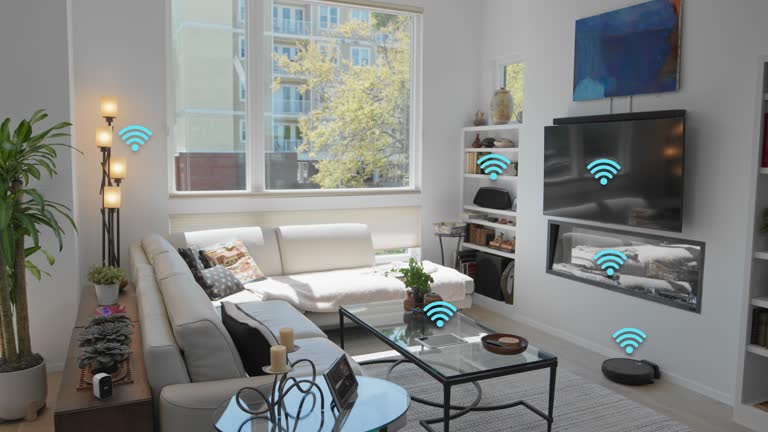
Wi-Fi Requirements for Smart Homes: Essential Insights for Seamless Connectivity
In today’s digital era, the concept of smart homes has become increasingly popular. As more devices connect to the internet, understanding the Wi-Fi requirements for smart homes is crucial. A reliable and fast Wi-Fi connection forms the backbone of any smart home, ensuring all devices function efficiently.
Whether you’re a tech enthusiast or someone looking to upgrade your living space, knowing the Wi-Fi requirements for smart homes is essential to make informed decisions. This guide will provide you with everything you need to ensure your smart home runs smoothly.

Importance of Wi-Fi in Smart Homes
Wi-Fi acts as the invisible thread that connects all your smart devices. From smart thermostats to security cameras, each gadget relies on a stable internet connection to function correctly. Without adequate Wi-Fi, devices may experience lag, connectivity issues, or even complete disconnection.
Understanding Bandwidth Needs
One of the first considerations for smart homes is bandwidth. Bandwidth determines how much data can be transmitted over your internet connection at one time. With multiple devices like phones, tablets, and smart gadgets vying for bandwidth, it’s vital to have a plan that can handle the load.
Router Placement and Its Impact
Where you place your router significantly impacts the strength and reach of your Wi-Fi signal. Ideally, your router should be centrally located to ensure even coverage throughout your home. Avoid placing it near thick walls or metal objects, as these can interfere with the signal.
Choosing the Right Router for Your Smart Home
Not all routers are created equal. When selecting a router for your smart home, consider factors such as the number of devices, the size of your home, and the types of activities you’ll be doing online.
Dual-Band vs. Tri-Band Routers
Dual-band routers offer two frequencies: 2.4 GHz and 5 GHz. The 2.4 GHz band provides a longer range, while the 5 GHz band offers faster speeds. Tri-band routers add an additional 5 GHz band, which can be beneficial for homes with many devices.
Wi-Fi 6: The Future of Connectivity
Wi-Fi 6 is the latest standard in wireless networking, offering improved speeds and better performance in crowded areas. Investing in a Wi-Fi 6 router can future-proof your smart home, ensuring it remains efficient as technology advances.
Security Considerations for Smart Home Networks
Security is a significant concern when it comes to smart homes. With multiple devices connected to the internet, ensuring your network is secure is paramount.
Setting Strong Passwords
One of the simplest ways to secure your network is by setting a strong, unique password. Avoid using common words or phrases, and consider changing your password regularly to maintain security.
Utilizing Network Segmentation
Network segmentation involves creating separate networks for different types of devices. This can help protect sensitive data and ensure that if one device is compromised, it doesn’t affect the entire network. For more insights on smart home security, visit Smart Home Security Integration.
Optimizing Wi-Fi for Maximum Efficiency
To get the most out of your Wi-Fi, consider optimizing your network for performance. This involves regular maintenance and updates to ensure everything runs smoothly.
Regularly Updating Firmware
Manufacturers often release firmware updates that improve performance and security. Regularly check for updates and install them to keep your network running efficiently.
Conducting Speed Tests
Conducting regular speed tests can help you identify any issues with your connection. If you notice a drop in speed, it may be time to upgrade your plan or your equipment.
Integrating Smart Devices with Seamless Connectivity
When integrating smart devices, ensure they’re compatible with your network. Check for compatibility with your router and make sure they support the same frequency bands.
Using Smart Hubs
Smart hubs can help centralize control of your devices, making it easier to manage them. They can also help improve connectivity by acting as a bridge between different devices.
For a detailed guide on integrating smart devices, visit Google Home.
Conclusion
Understanding the Wi-Fi requirements for smart homes is crucial for anyone looking to create a connected and efficient living space. From choosing the right router to ensuring security, every step plays a vital role in the overall performance of your smart home.

FAQ
What is the best router for a smart home?
The best router depends on your specific needs, including the number of devices and the size of your home. Consider a Wi-Fi 6 router for future-proofing your network.
How can I improve Wi-Fi coverage in my home?
Improve coverage by placing your router in a central location, using Wi-Fi extenders, or upgrading to a more powerful router.
Are smart home devices safe to use?
Yes, but it’s important to use strong passwords and secure your network to protect against potential threats. Learn more about integrating devices safely at Smart Home Automation Explained.
This article contains affiliate links. We may earn a commission at no extra cost to you.